
A rangefinder camera is a camera fitted with a rangefinder, typically a split-image rangefinder: a range-finding focusing mechanism allowing the photographer to measure the subject distance and take photographs that are in sharp focus.
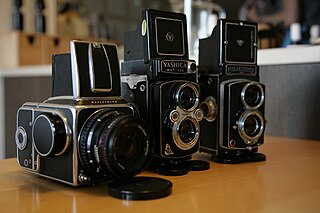
Medium format has traditionally referred to a film format in photography and the related cameras and equipment that use film. Nowadays, the term applies to film and digital cameras that record images on media larger than the 24 mm × 36 mm used in 35 mm photography, but smaller than 4 in × 5 in.

Pentax Corporation was a Japanese camera and optical equipment manufacturer, and currently, it exists as the Pentax Life Care Business Division of Hoya's medical endoscope business, as well as the digital camera brand of Ricoh Imaging, a subsidiary of Ricoh.

The Ricoh Company, Ltd. is a Japanese multinational imaging and electronics company. It was founded by the now-defunct commercial division of the Institute of Physical and Chemical Research (Riken) known as the Riken Concern, on 6 February 1936 as Riken Sensitized Paper. Ricoh's headquarters are located in Ōta, Tokyo.

Advanced Photo System type-C (APS-C) is an image sensor format approximately equivalent in size to the Advanced Photo System film negative in its C ("Classic") format, of 25.1×16.7 mm, an aspect ratio of 3:2 and Ø 30.15 mm field diameter. It is therefore also equivalent in size to the Super 35 motion picture film format, which has the dimensions of 24.89 mm × 18.66 mm and Ø 31.11 mm field diameter.

The Pentax K-mount, sometimes referred to as the "PK-mount", is a bayonet lens mount standard for mounting interchangeable photographic lenses to 35 mm single-lens reflex (SLR) cameras. It was created by Pentax in 1975, and has since been used by all Pentax 35 mm and digital SLRs and also the MILC Pentax K-01. A number of other manufacturers have also produced many K-mount lenses and K-mount cameras.

The Nikon FM10 is a manual focus 35 mm film camera formerly sold by Nikon Corporation. It is of SLR design and was first available in 1995. It is normally sold in a kit that includes a Zoom Nikkor 35–70 mm f/3.5-4.8 zoom lens, although a Zoom Nikkor 70–210 mm f/4.5-5.6 zoom lens is also available. An electronic companion model known as the FE10 was also sold at one stage.

The Bessa family of cameras was manufactured in Japan by Cosina as a revival of the Voigtländer brand name between 1999 and 2015.

The Ricoh GR Digital II is a compact digital camera, the successor of the Ricoh GR Digital and one of a series of Ricoh GR digital cameras.
This article discusses the cameras – mainly 35 mm SLRs – manufactured by Pentax Ricoh Imaging Corp. and its predecessors, Pentax Corporation and Asahi Optical Co., Ltd.. Pentax must not be confused with Pentax 6x7 or Pentax 67 which are 120 medium format 6x7cm film cameras.

Pentax lenses were first badged as Takumar. The Takumar branded lenses were well respected for their line of Super Takumar, which designated the high performance coating applied to the lens as well as the optical formulas used to make them. The majority of the industry at the time was still satisfied with the variations of the "plumb" coating process and later some of the two and three layer processes as well. Asahi Pentax soon introduced the Takumar Super-Multi-Coated line of lenses which was a 7 layer process as the industry had just caught up with similar forms of 5 layer multi-coated optics. Eventually Asahi Optical and Pentax slowly shifted much of their lens production under the Pentax name and transitioned some of the successful designs that were first introduced under the Takumar name to use Asahi/Pentax badging as well as beginning to use the "smc" abbreviation. Eventually the Asahi partnership disappeared and the Pentax name became solely used. Pentax lenses saw many feature changes to answer the market, such as: incorporating "Auto-Aperture" with the M42, the light weight and compactness with the 'M' series, Aperture Priority overrides with the 'A' series, and Auto-Focus with the 'F' series. Modern Pentax lenses for digital SLR cameras have seen the elimination of the aperture ring completely as found on Pentax DA and D-FA series lenses. They use the Pentax KAF mount. All of these lenses have an autofocus feature, either operated from the camera body or from an internal SDM motor. Pentax compatible lenses are also made by third-party companies.
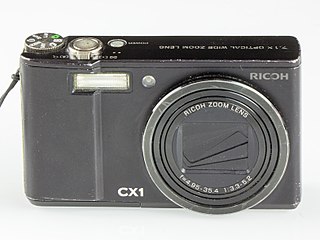
The Ricoh CX1 has been introduced by Ricoh in 2009. This is the first Ricoh camera to use a CMOS sensor. It allows it to operate at four frames/sec and perform hi-speed continuous shooting.

The Ricoh GR was a series of point-and-shoot, or compact, 35 mm film cameras made by Ricoh and introduced between 1996 and 2001. Specific camera models include the GR1, GR10, GR1s, GR1v, and GR21. The GR name was later used for Ricoh's GR series of digital cameras, which began production in 2005.
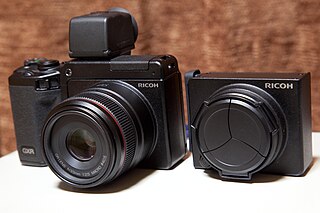
The Ricoh GXR is a compact digital camera first announced by Ricoh Company, Ltd, Tokyo on November 10, 2009. Unlike conventional cameras which either have a fixed lens and sensor or interchangeable lens and a fixed sensor, the GXR takes interchangeable units, each housing a lens, sensor and image processing engine, sometimes called a "lensor" as a portmanteau of lens and sensor.

A mirrorless camera is a digital camera which, in contrast to DSLRs, does not use a mirror in order to ensure that the image presented to the photographer through the viewfinder is identical to that taken by the camera. They have come to replace DSLRs, which have historically dominated interchangeable lens cameras. Other terms include electronic viewfinder interchangeable lens (EVIL) cameras and compact system cameras (CSCs).
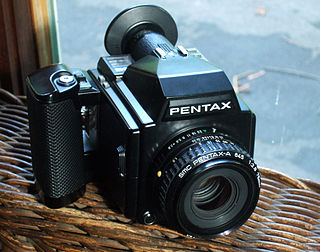
The Pentax 645 is a medium format single-lens reflex system camera manufactured by Pentax. It was introduced in 1984, along with a complementary line of lenses. It captures images nominally 6 cm × 4.5 cm on 120, 220, and 70 mm film, though the actual size of the images is 56 mm × 41.5 mm.

The Ricoh GR is a digital large sensor compact camera announced by Ricoh on April 17, 2013, one of a number of Ricoh GR digital cameras. It was succeeded by the Ricoh GR II in 2015, the Ricoh GR III in 2019, and the GR IIIx in 2021.

The Ricoh GR is a series of point-and-shoot, or compact, digital cameras made by Ricoh. The GR name was previously used for Ricoh's GR series of film cameras. Like the GR film cameras and Fujifilm X70, the GR digital cameras use metal bodies fitted with bright, permanently-attached prime lenses. In general, the GR digital cameras follow the precedent set by the original GR1 (1996) with lenses that provide a field of view equivalent to a 28 mm wide angle lens on a 35mm film camera.
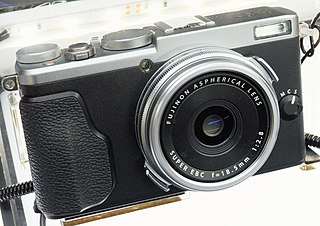
The Fujifilm X70 is an APS-C sensor digital compact camera with an 18.5 mm fixed prime lens. It is part of Fujifilm's X-Series of cameras. It was announced in January 2016 and was released on 18 February 2016.
The Contax T camera line consists of a number of compact cameras sold by Kyocera under the Contax brand. They were introduced between 1984 and 2002. The T, T2, and T3 use 35mm film and have a fixed 35 mm wide-angle lens. The T-VS, T-VS II, and T-VS III also use 35 mm film but have a 28–56 mm lens. The Tix uses APS film and has a fixed 28 mm wide-angle lens. The TVS Digital is a 5 MP digital camera with a 35–105 mm (equivalent) lens.



















